How do you plan a successful butterfly and pollinator garden?
With the increased awareness of pollinator decline, gardeners are asking that question alot lately.
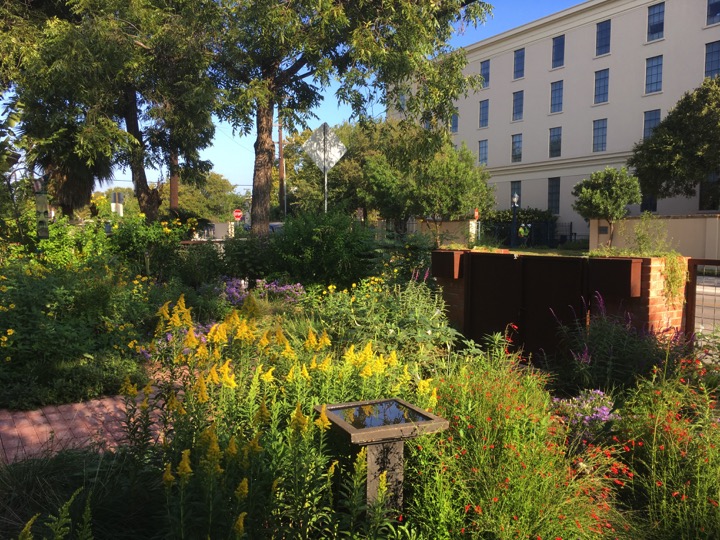
Late season goldenrod in downtown San Antonio. Ready for migrating monarchs and other pollinators. Photo by Monika Maeckle
Pollinators–bees, in particular–make one of every three bites of food we eat possible, delivering billions of dollars of free ecosystem services to humanity each year. Without them, the foods we know and love would become less available and more expensive. As climate change, pesticide abuse, genetically modified crops and urban sprawl conspire to limit pollinator habitat world-wide, governments are worried about food security in the face of their demise.
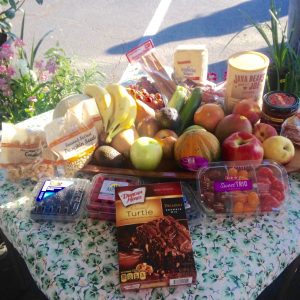
Insect pollinators make all these edibles–and many others–possible. Photo by Monika Maeckle
That thinking drove the announcement of President Barack Obama’s National Pollinator Strategy, issued in 2015. The 58-page document sets goals to reduce honey bee losses, increase the migrating Monarch butterfly population, and restore seven million acres of pollinator habitat over the next five years.
Large prairie restorations have since been underway as funding and attention have focused on the IH-35 corridor, which serves as a major migration route for birds, insects and Monarchs. Every yard also makes a difference.
In fact, an October 2015 study, An Evaluation of Butterfly Gardens for Restoring Habitat for the Monarch Butterfly, by Brian T. Cutting and Douglas W. Tallamy published in Environmental Entomology, a publication of the Entomological Society of America,
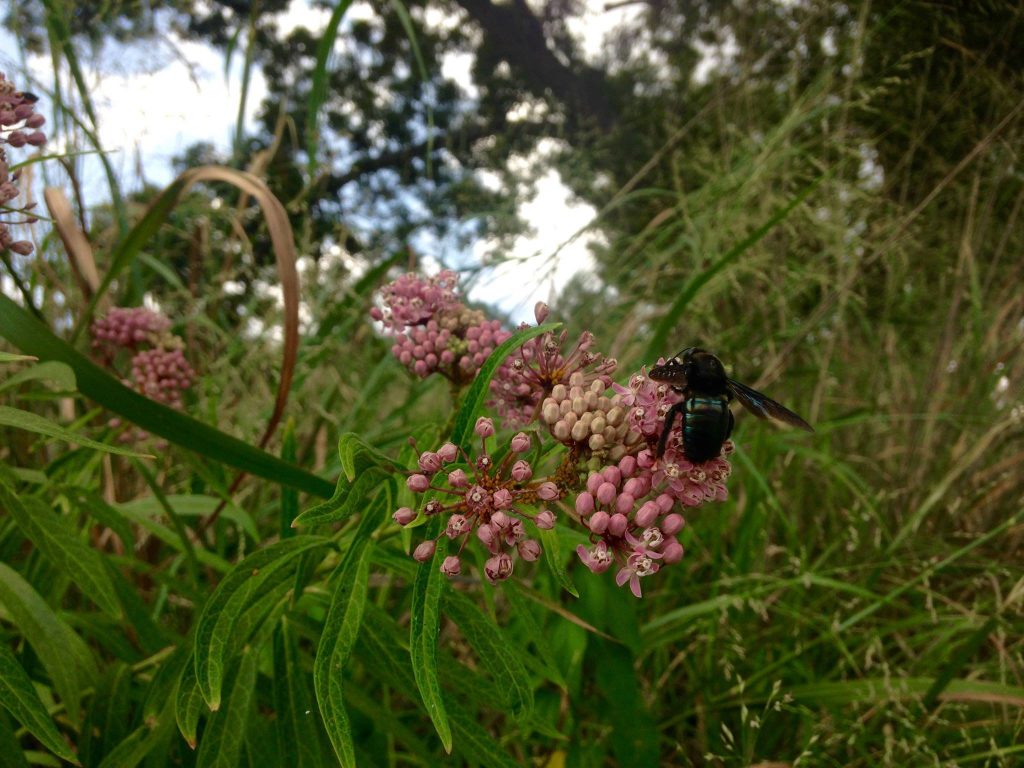
Everyone loves Swamp milkweed. Here, aphids and a glamorous blue bumblebee pour over the blooms. Photo by Monika Maeckle
demonstrated that Monarch butterflies are much more likely to lay their eggs in gardens than in natural sites–2.0 – 6.2 times more eggs per plant per observation. That suggests planting butterfly and pollinator gardens can make a significant contribution to restoring habitat for these special creatures that keep our food web intact.
How to do it? Here’s a few tips:
Ask: How will I use my garden?
Do you want a deck or patio as part of your pollinator garden? A fire pit? Rain garden? Do you prefer a path for observing pollinators in the their various stages as well as the fruits, flowers and herbs you might be growing? Or maybe you just want a pretty yarden with bees buzzing, hummingbirds lighting and butterflies lilting on your flowers?
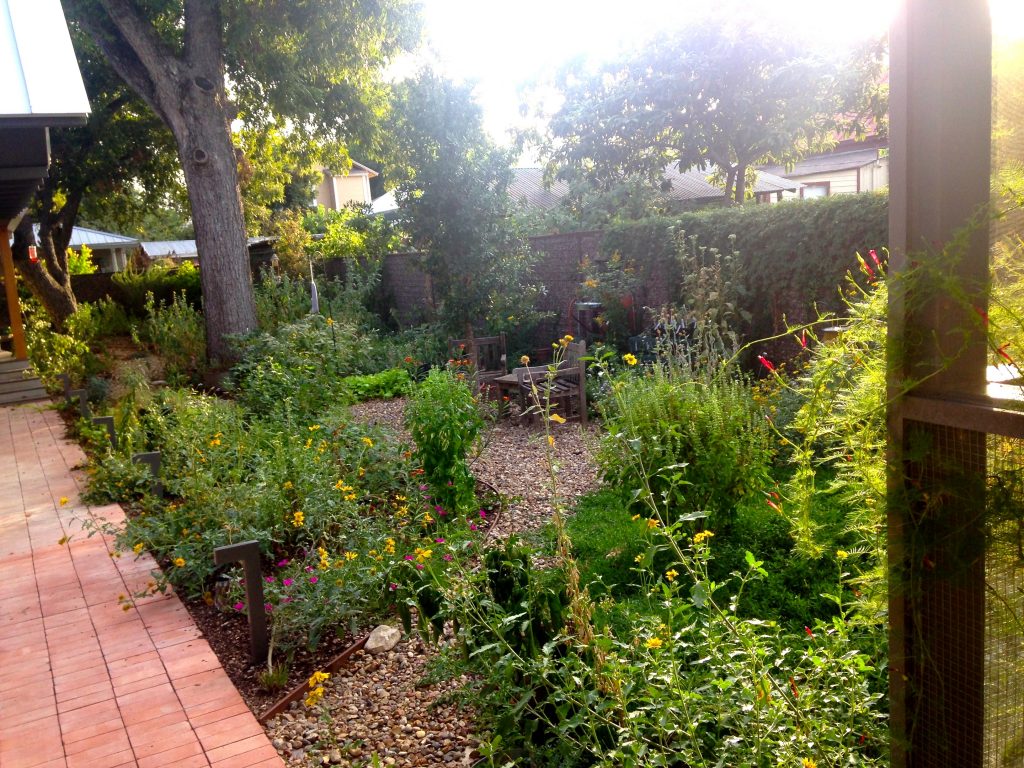
I like a path in my pollinator garden so I can check for caterpillars and eggs, pick some okra, or snip some herbs for dinner. Photo by Monika Maeckle
How you will use your garden will determine how to plan the space. Personally, I like to come home from work and walk through my garden in the late afternoon and early evening, inspecting my milkweeds and other host plants for eggs and caterpillars, checking on the okra or tomatoes and perhaps snipping some herbs for dinner. That’s why I’ve incorporated gravel and mulch paths that weave throughout the garden to allow access and close inspection, as well as close-up photography that you will often see in these webpages.
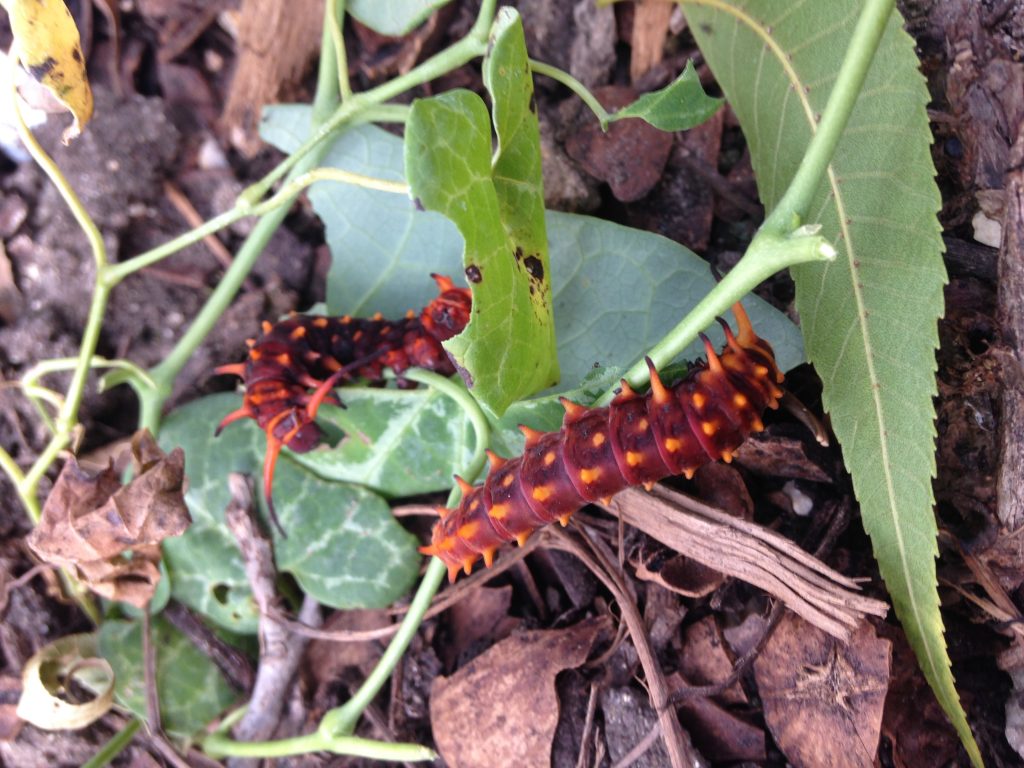
Pipevine swallowtail caterpillars on Dutchman’s Pipe. PHoto by Monika Maeckle
I understand that not everyone fancies that. Some folks want the focal point of their garden to be a barbecue zone or vegetable patch, or perhaps a hammock/reading area, a deck, a pond or rain garden. You decide. It’s your garden. Plants can be identified to serve any situation—wet, dry, sunny, shady. So choose.
And while you’re at it: choose native and well adapted plants.
I’m not a purist about native plants, but I do try to use them whenever possible. Why?
Because natives are four times more likely to attract pollinators than exotics. Makes sense, since the natives were born and raised here, thus the insects that interact with them are naturally predisposed to perform the valuable ecosystem services needed to be self-sustaining. According to Pollinators of Native Plants, a fantastic book by Heather N. Holm, studies find that when eight or more species of native plants occupy a
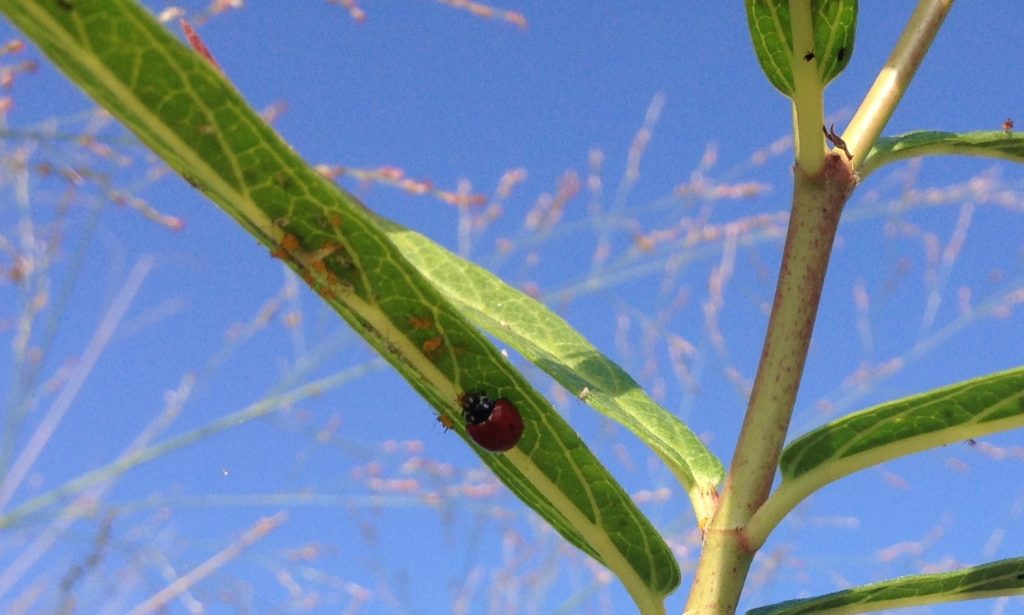
Lady bug on the job tackling aphids on Swamp milkweed. Photo by Monika Maeckle
landscape, the population and variety of native bees increase. Diverse native landscapes also support beneficial insects like lady bugs, who seemingly appear out of nowhere to combat the yellow aphids that gravitate to the milkweeds we all plant for Monarchs and other butterflies.
Choose nectar and host plants to draw your favorite butterflies
Butterflies and moths feed mostly on nectar plants, their flowers providing a sugary fluid that fuels their flight and reproduction. As caterpillars, they consume the leaves of particular plants known as host plants. Bees, meanwhile, feed on a flower’s pollen (protein) and nectar (carbs). If you plant a variety of nectar and host plants, you should attract butterflies and bees to your yard. Most people focus on the flowers, failing to research and include host plants, but honestly host plants are the key to a successful butterfly garden.
For example, we all know that Monarch butterflies eat milkweed, anything in the Asclepias family. But did you know that Eastern Swallowtails, one of the most common and beautiful butterflies in our part of the world, eat plants in the carrot family, Apiaceae? That means if you plant parsley, fennel, dill or rue, you will soon have Eastern Swallowtails in your yard. They are magnificent caterpillars and dramatic, large flyers in the adult stage.
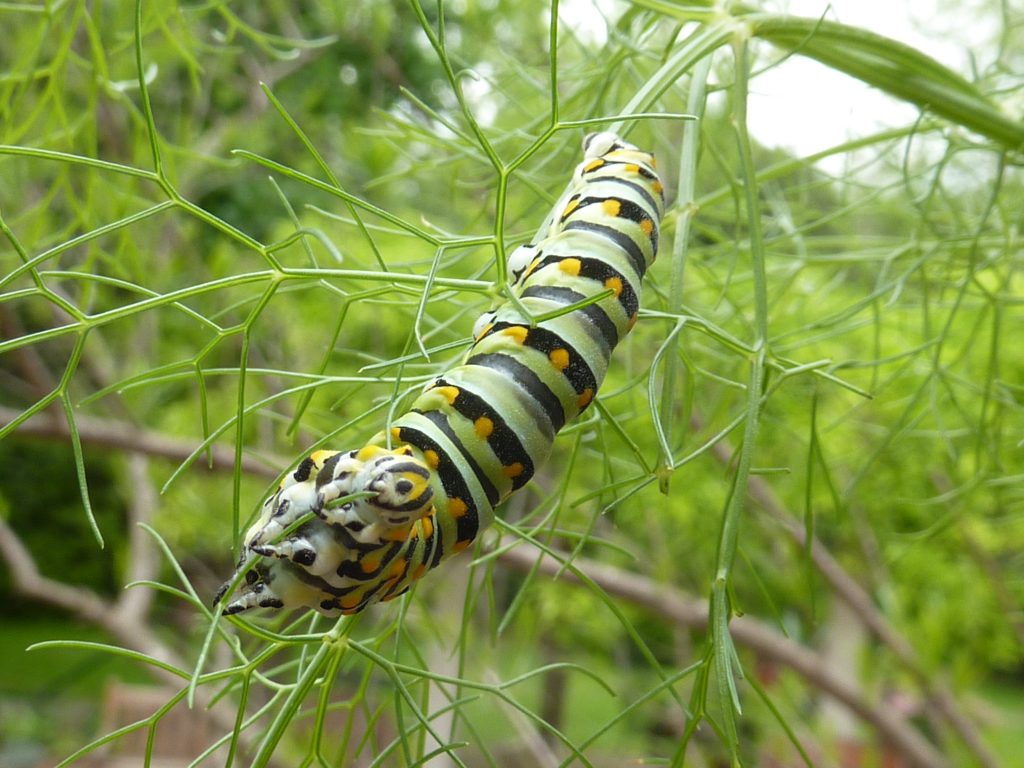
Eastern Swallowtails eat plants in the carrot family–parsley, fennel, dill and rue. Here, a Swallowtail noshing on fennel. Photo by Monika Maeckle
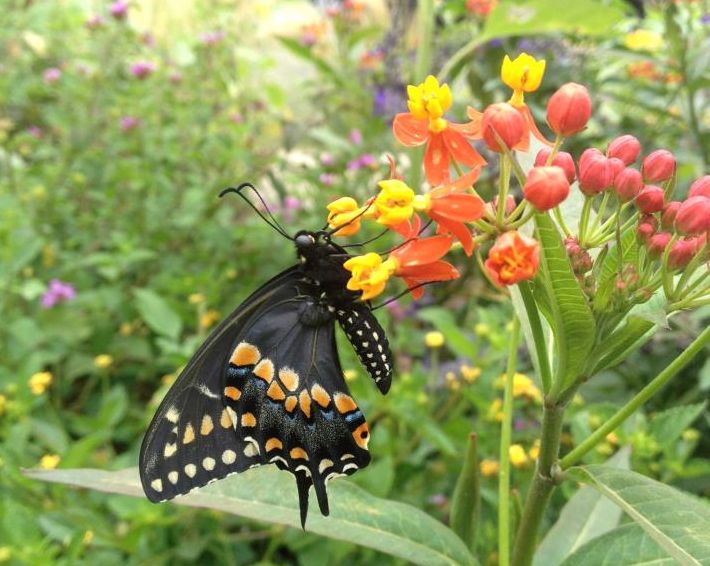
Eastern Swallowtails, like many butterflies, are less particular about their nectar sources. Here, Swallowtail nectaring on Tropical milkweed. Photo by Monika Maeckle
If you need help identifying appropriate native host and nectar plants that will attract the butterflies and other pollinators in your area, consult your local native plant society or Master Gardeners Chapter. Typically they offer lists of “butterfly garden” plants appropriate for your locale.
Right plant in the right place
Ideally, you want a sunny location. Butterflies, bees and hummingbirds like flowers and flowers need sun–preferably six – eight hours per day. Determining the sun’s arc—that is, how the sun and shade play on your pollinator garden will determine where you place particular plants. Sunflowers, mistflowers, sages and asters must have sun to bloom; planting them under a tree or eave will only disappoint you–and the bees and butterflies, too.
Shade options include Columbine, Turk’s Cap, and certain Goldenrods as excellent pollinator plants. These and others thrive on the edge of a tree’s shade or in roofline’s shadow. Again, consult your local native plant society and Master Gardener chapters to see what’s right for your situation.
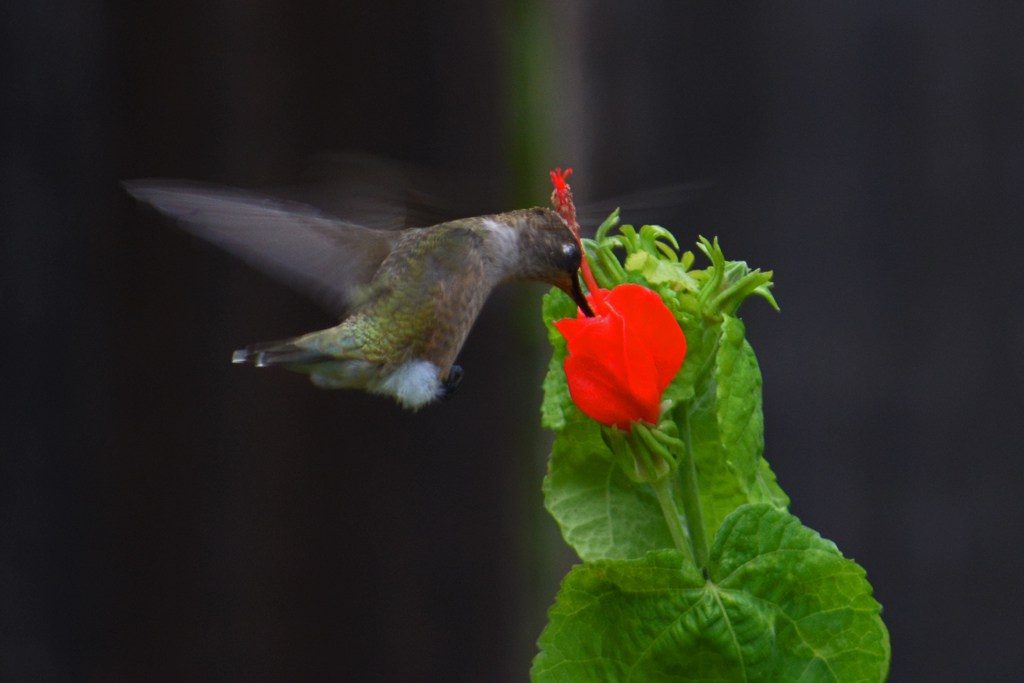
Hummingbirds love Turk’s Cap, which grows in shade. Photo via npsot.org
Meanwhile, ask yourself: what kind of soil do I have? Blackland prairie or rock-filled caliche? Loam, sand, silty? The soil is the foundation of the garden and some plants will only grow in particular circumstances with the requisite moisture and nutrients. You can do a simple soil test or simply observe a similar natural landscape and copy Mother Nature.
Avoid pesticides
Butterflies, caterpillars, beetles, ants, wasps, hummingbirds and moths are sensitive creatures that readily absorb pesticides, which are poisons. When caterpillars, or butterflies-to-be as I like to call them, eat the leaves of plants sprayed with systemic pesticides, they perish. Systemic pesticides can linger in a plant for months.
In the photo below, a trusted nursery assured our friend Sharon Sander that they had not sprayed the milkweeds she sought with any pesticides. Sander bought several one-gallon milkweeds to feed her hungry Monarch caterpillars. The nursery employee was correct–they had NOT sprayed the plant. But the grower did. The systemic pesticide used remained in the milkweed leaves for months, killing all the caterpillars.
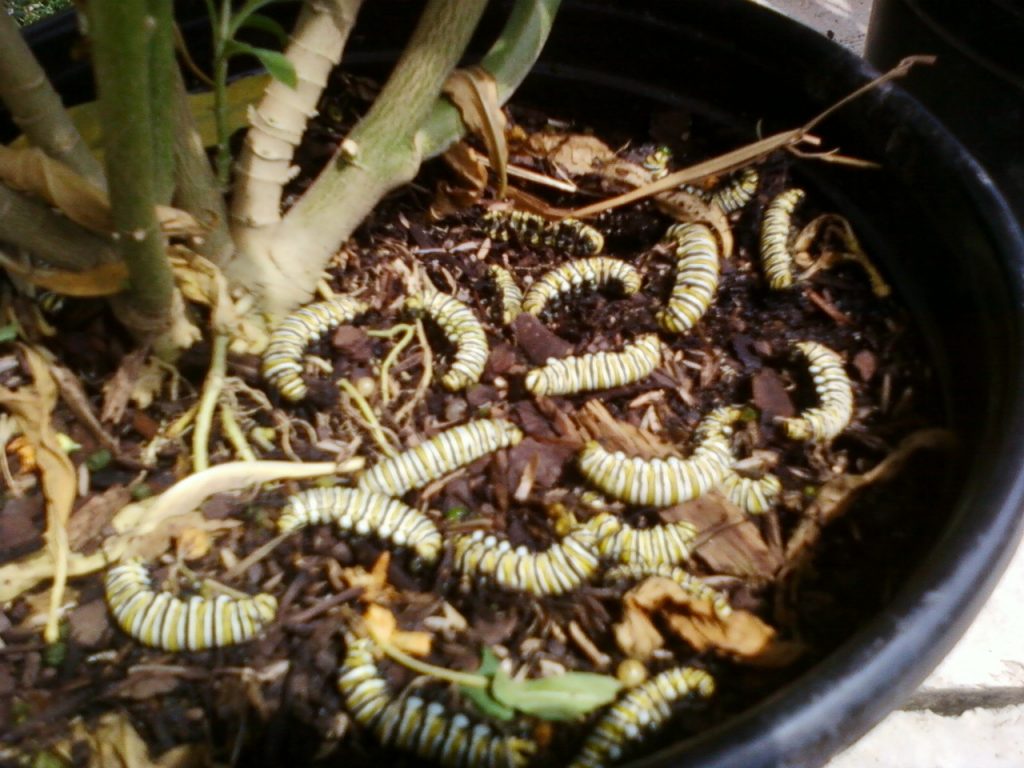
Boo-hoo! Dead Monarch caterpillars fall victim to pesticide laced milkweed. Photo by Sharon Sander
Seek out growers and nurseries that do not use systemic pesticides. And if you must use pesticides yourself, read and follow the directions carefully. Choose a still day, not when it’s windy, and avoid spraying if rain is in the forecast, since the poisons might wash off and run into streams or drains. Also, spray or apply surgically, ONLY to the plant that has issues, not some mass broadswipe.
For more on how to safely use pesticides in a pollinator garden, check out this helpful flyer from the Pollinator Partnership.
Create a puddling zone and wind break
Butterflies need damp, wet areas to rehydrate and soak up minerals from the soil. A small swale or even a rain garden can satisfy this need and create a microhabitat within your garden that brings a new pollinator audience to your yard.
We installed a rain garden last year, planting its perimeter with various sedges, native grasses and Texas Frogfruit, Phyla nodiflora, a lovely semi-evergreen groundcover that thrives in extreme wet and dry conditions. A member of the verbena family,
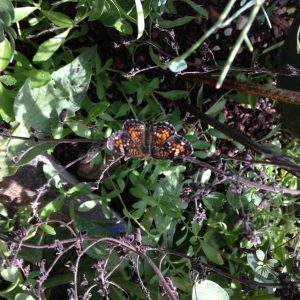
Phaeon crescentspot on frogfruit. Photo by Monika Maeckle
Frogfruit’s tiny white flowers serve as an excellent nectar source for various butterflies and as host plant to the Common Buckeye, Phaeon Crescentspot, and White Peacock butterflies.
Bushes, trees, and tall shrubbery also are necessary to provide pollinators a place to rest, roost and overnight. You can make these flowering plants if you like, but it’s not necessary. Monarchs roost every fall in pecan trees that offer no nectar or hosting, only protection from the wind and the elements.
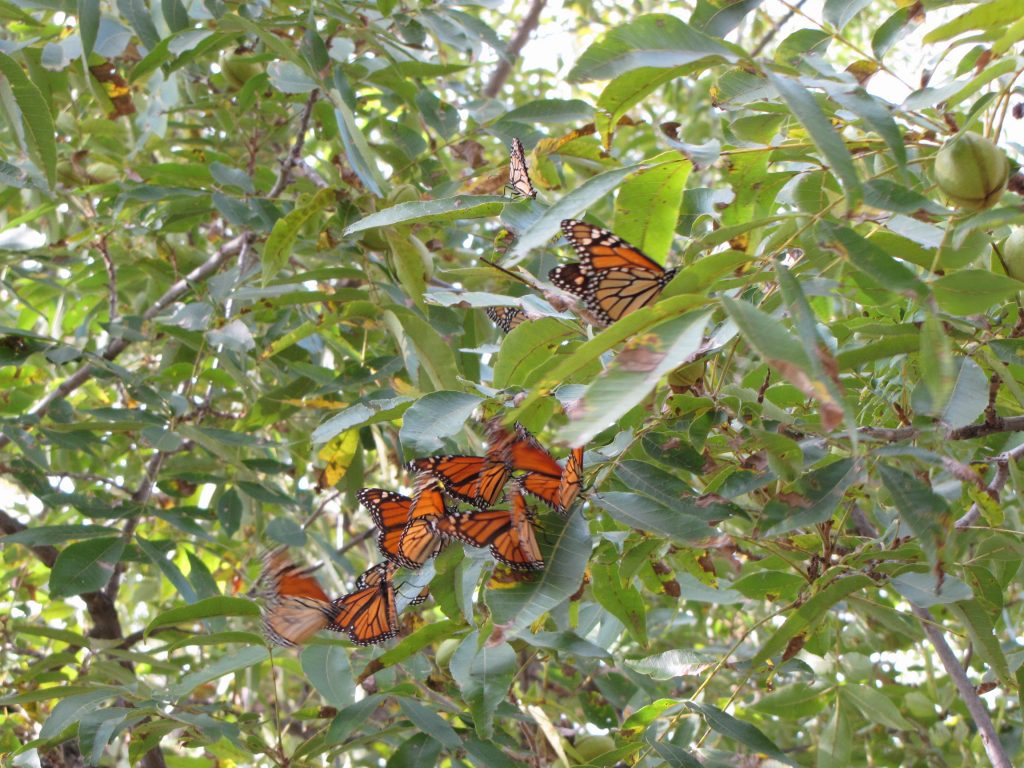
Monarch butterflies take a break from the wind by roosting and resting in pecan trees along the Llano River. Photo by Monika Maeckle
Don’t expect year-round tidiness
This is one of the toughest lessons for city folk. Pollinator and native gardens go through messy stages. And for good reason.
Annuals like Cowpen Daisy, Verbesina encelioides, “go to seed” and when they do, some people consider them impossibly unattractive. I had a neighbor in Austin who loathed my butterfly garden adjacent to his well-manicured lawn. When I vacated my apartment in the autumn he took
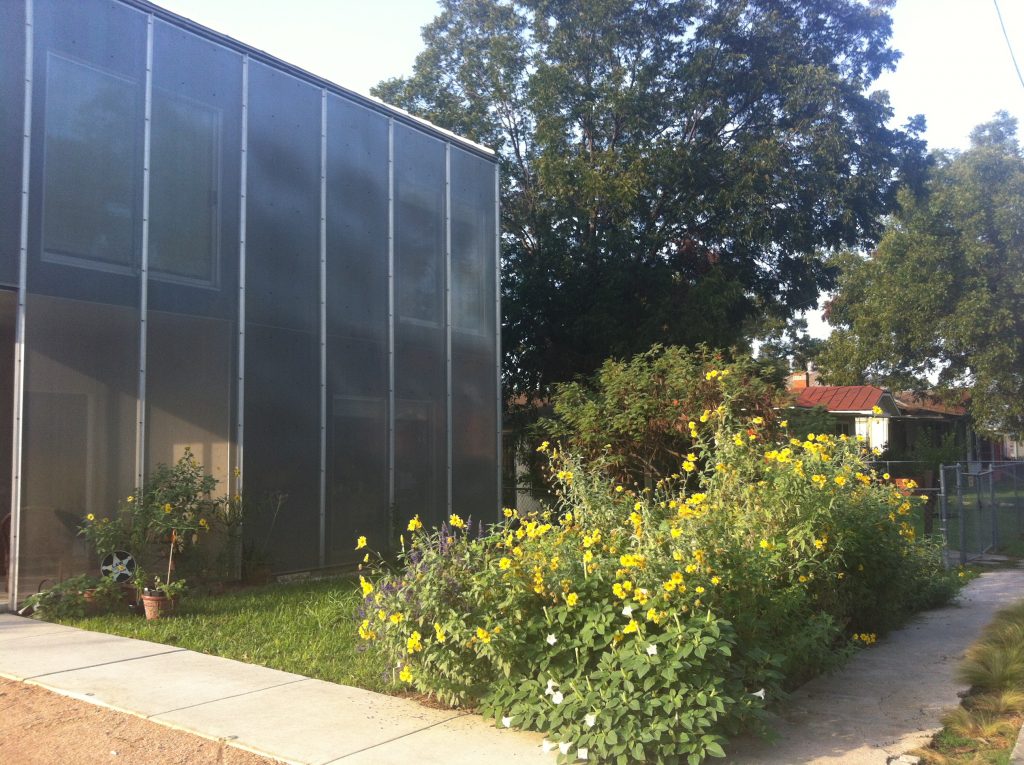
San Antonio butterfly garden, October 2012. Photo by Monika Maeckle
it upon himself to mow down my Daisy patch and reinstall St. Augustine. The same attitude removed a well established pollinator patch from our former family home in Alamo Heights. When we turned over the keys, the new owners ripped out all the shrubs and natives and returned the lawn to water guzzling grass.
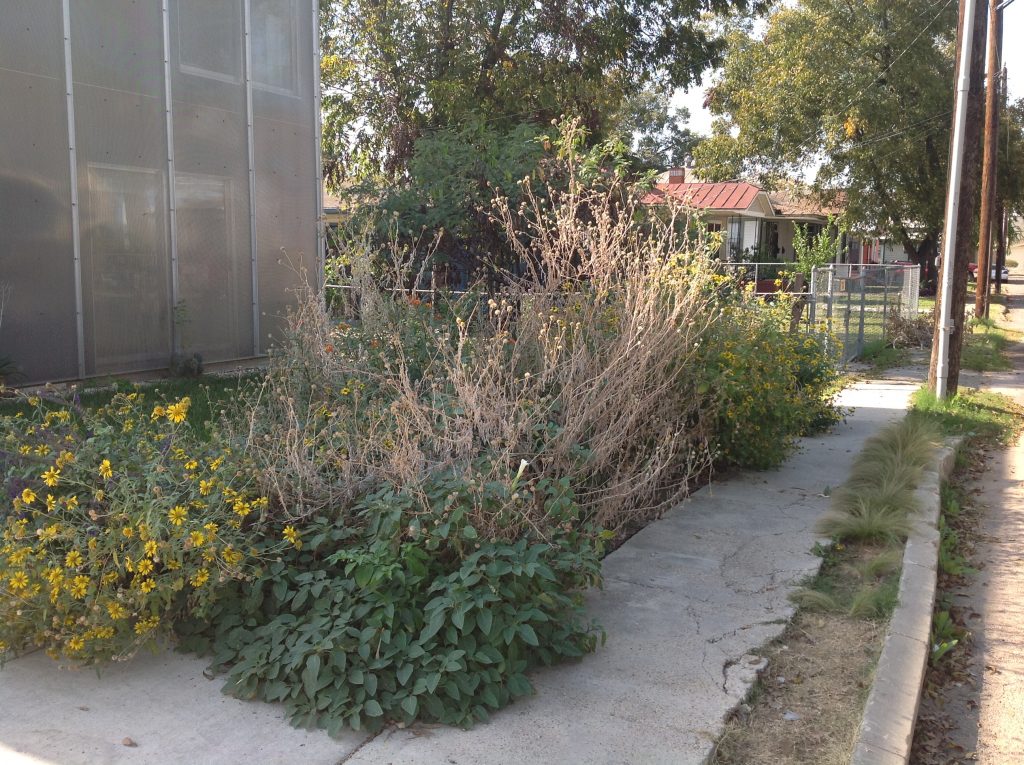
San Antonio butterfly garden, November 2012. Some Cowpen Daisies are spent–good time to gather seeds for next year. Photo by Monika Maeckle
It’s a fact: nature is messy. Sometimes pollinator gardens are not that pretty. Seedpods form and dry, become brittle, and hang on the plant, reminding us of better days. Dead vines and stalks may look raggedy and unsightly, yet they provide shelter and protection for all kinds of creatures. Just remember that the pay-off for such temporary imperfection is a new round of beauty in seasons to come.
Related posts:
- Mostly native butterfly garden outperforms lawn every time
- A year in the life of an urban butterfly garden
- Downtown River walk plot converts to pollinator garden, creature haven
- Converting your Lawn to a Butterfly Garden
- San Antonio becomes first National Wildlife Federation Monarch Champion city
- Late season Monarchs create gardening quandary
- What to do with late season Monarchs
- Tropical Milkweed: To Plant it or Not is No Simple Question
- How to raise Eastern Swallowtails
- How to raise Monarch butterflies at home
Like what you’re reading? Don’t miss a single post from the Texas Butterfly Ranch. Sign up for email delivery, like us on Facebook, or follow us on Twitter, @monikam.

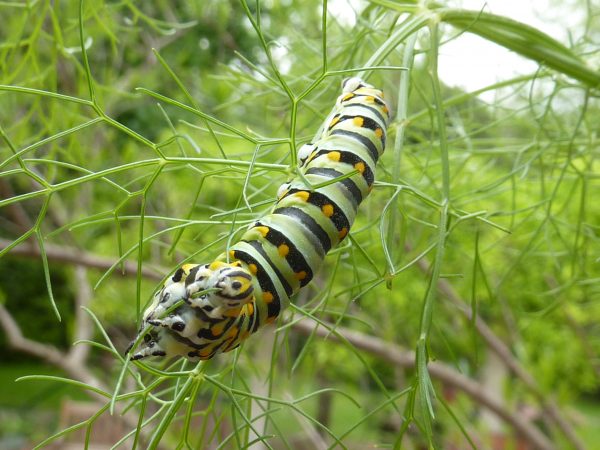
Excellent introductory article for new gardeners, and those looking to convert to pollinator gardens. I posted this to our Central Texas Backyard Gardeners Facebook group.
In central Texas the first generation of Tiger Swallowtails took flight
this week. Black Swallowtails, cabbage whites, sulfurs, clouded sulfurs , and spangled fritillaries to name a few are in the air already. Nights in the 40s and days in the 70s. My first monarch was sighted at the Texaco station yesterday in Jonestown, Texas. Fueling up I guess. 👩🌾
Thank you Monica for another great post. The link to Master Gardeners was incorrect. Perhaps you meant to insert this one? https://mastergardener.tamu.edu/county-programs/
Done! Thank you for helping me get it right! -MM
40,0000 +. Monarch enthusiates are raising and releasing monarch caterpillars and eggs they find in their pollinator gardens please plant host and nectar plants so you too can raise butterflies and add to the monarch population too.
Somewhere i read that once in a while when there are no eggs or traces of the butterflies, it is good to spray with a hand sprayer a mixture of water and a tea spoon of bleach to eliminate problems with a virus or mold issues. Have you heard about this?
Thank you so much for addressing the pesticide issue. Unfortunately most articles published leave this part out. The use of neonicitinoids by growers and how detrimental it is to pollinators must be brought to the attention of the general public. Many gardeners think they are doing good by providing plants pollinators like but when those plants are laced with pesticides, well what then. Keep spreading the word. Thanks
Raising Monarchs in Central Pennsylvania my third year in a row. Will hopefully have released over 50 by the end of the season in spite of irregular weather patterns. You really do need to pore over your outdoor milkweed leaves 2 or 3 times a day. Checking the top, most tender leaves is more fruitful than the lower down coarse ones that seem to inhabit more ground crawling predators (ants, etc). Be sure to wash your leaves in cool water and inspect for aphids, spiders, etc., before setting them in vials for the cats.
You have to work at this hobby everyday, 2 or 3 times checking on your wards. Little ones fall off their leaves or get eaten by bigger cats if one is on the same leaf. I segregate mine by age: kindergarten, grammar school, high school and, finally, college for the big guys.
My concern is when they hatch during raining weather. I have provided a bouquet of garden flowers, but will have to think of other ways to provide them with nourishment until the sun shines. One article I have read tells of putting a sugar soaked Q-tip near the proboscis or putting the butterfly on a sugar soaked sponge until it detects the nectar and can begin eating. I would welcome any other advice. 3 hatched yesterday (9/10/22) and so far have just clung to the netting.
Any ideas are welcome. I am planning to move to where I can establish a larger, more comprehensive butterfly and moth garden with all the varieties of plants necessary.